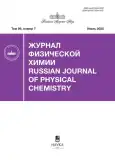Nickel-containing catalysts based on rice husk for hydrogenation of carbon dioxide to produce methane
- Авторлар: Rodin V.Y.1, Novotortsev R.Y.2, Magdalinova N.A.1, Savilov S.V.2,3
-
Мекемелер:
- Ivanovo State University
- Lomonosov Moscow State University
- A.V. Topchiev Institute of Petrochemical Synthesis, Russian Academy of Sciences
- Шығарылым: Том 99, № 7 (2025)
- Беттер: 1004-1015
- Бөлім: CHEMICAL KINETICS AND CATALYSIS
- ##submission.dateSubmitted##: 17.10.2025
- ##submission.datePublished##: 15.07.2025
- URL: https://vestnik-pp.samgtu.ru/0044-4537/article/view/693641
- DOI: https://doi.org/10.7868/S3034553725070055
- ID: 693641
Дәйексөз келтіру
Аннотация
The synthesis of nickel catalyst for hydrogenation of carbon dioxide to methane on a carrier obtained by rice husk pyrolysis is proposed. The original synthetic approach consists in annealing rice husk in the presence of nickel nitrate at 500–700°C, which reduces the labor, time and energy consumption for the synthesis. Comparison of nickel catalysts obtained using different conditions of calcination in different number of stages shows that the proposed method allows to achieve activity (18.8 h–1), comparable to literature data. At the same time, Mn promotion significantly improves its performance. This approach may be important for the development of efficient catalysts for CO2 hydrogenation with methane production and further application of rice husk in catalysis.
Негізгі сөздер
Авторлар туралы
V. Rodin
Ivanovo State University
Email: viacheslav.rodin@chemistry.msu.ru
Ivanovo, Russia
R. Novotortsev
Lomonosov Moscow State UniversityMoscow, Russia
N. Magdalinova
Ivanovo State UniversityIvanovo, Russia
S. Savilov
Lomonosov Moscow State University; A.V. Topchiev Institute of Petrochemical Synthesis, Russian Academy of SciencesMoscow, Russia; Moscow, Russia
Әдебиет тізімі
- MohdRidzuan N.D., Shaharun M.S., Anawar M.A., Ud-Din I. // Catalysts. 2022. V. 12. № 5. P. 469. https://doi.org/10.3390/catal12050469.
- Netskina O.V., Dmitruk K.A., Mazina O.I. et al. // Mater. 2023. V. 16. № 7. P. 2616. https://doi.org/10.3390/ma16072616.
- Lim J.Y., Safder U., How B.S. et al. // Appl. Energy. 2021. V. 283. P. 116302. https://doi.org/10.1016/j.apenergy.2020.116302.
- Šnajdrová V., Hlinčík T., Ciahotný K., Polák L. // Chem. Pap. 2018. V. 72. P. 2339. https://doi.org/10.1007/s11696-018-0456-0.
- Aziz M.A.A., Jalil A.A., Triwahyono S. et al. // Appl. Catal. B. 2014. V. 147. P. 359. https://doi.org/10.1016/j.apcatb.2013.09.015.
- Rahmani S., Rezaei M., Meshkani F. // J. Ind. Eng. Chem. 2014. V. 20. № 6. P. 4176. https://doi.org/10.1016/j.jiec.2014.01.017.
- Singh B. Rice husk ash. In Woodhead Publishing Series in Civil and Structural Engineering, Waste and Supplementary Cementitious Materials in Concrete / Eds. R. Siddique, P. Cachim. Woodhead Publishing. 2018. P. 417. https://doi.org/10.1016/B978-0-08-102156-9.00013-4.
- Mazilan M.S.R., Sulaiman S.Z., Semawi N.H. et al. // Mater. Today: Proc. 2023. https://doi.org/10.1016/j.matpr.2023.08.143.
- Chernyak S., Rodin V., Novotortsev R.et al. // Catal. Today. 2023. V. 424. P. 113846. https://doi.org/10.1016/j.cattod.2022.07.014.
- Paviotti M.A., Salazar Hoyos L.A., Busilacchio V. et al. // J. CO2 Util. 2020. V. 42. P. 101328. https://doi.org/10.1016/j.jcou.2020.101328.
- Thommes M. et al. // Pure and applied chemistry. 2015. V. 87. № 9–10. P. 1051. https://doi.org/10.1515/pac-2014-1117
- Lv C., Xu L., Chen M. et al. // Front. Chem. 2020. V. 8. P. 269. https://doi.org/10.3389/fchem.2020.00269.
- Ye R.-P., Gong W., Sun Z. et al. // Energy. 2019. V. 188. P. 116059. https://doi.org/10.1016/j.energy.2019.116059.
- Zhu P., Chen Q., Yoneyama Y., Tsubaki N. // RSC Adv. 2014. № 4. P. 64617. https://doi.org/10.1039/C4RA12861C.
- Zhao Z.W., Zhou X., Liu Y.-N. et al. // Catal. Sci. Technol. 2018. Т. 8. № 12. P. 3160. https://doi.org/10.1039/C8CY00468D.
Қосымша файлдар









